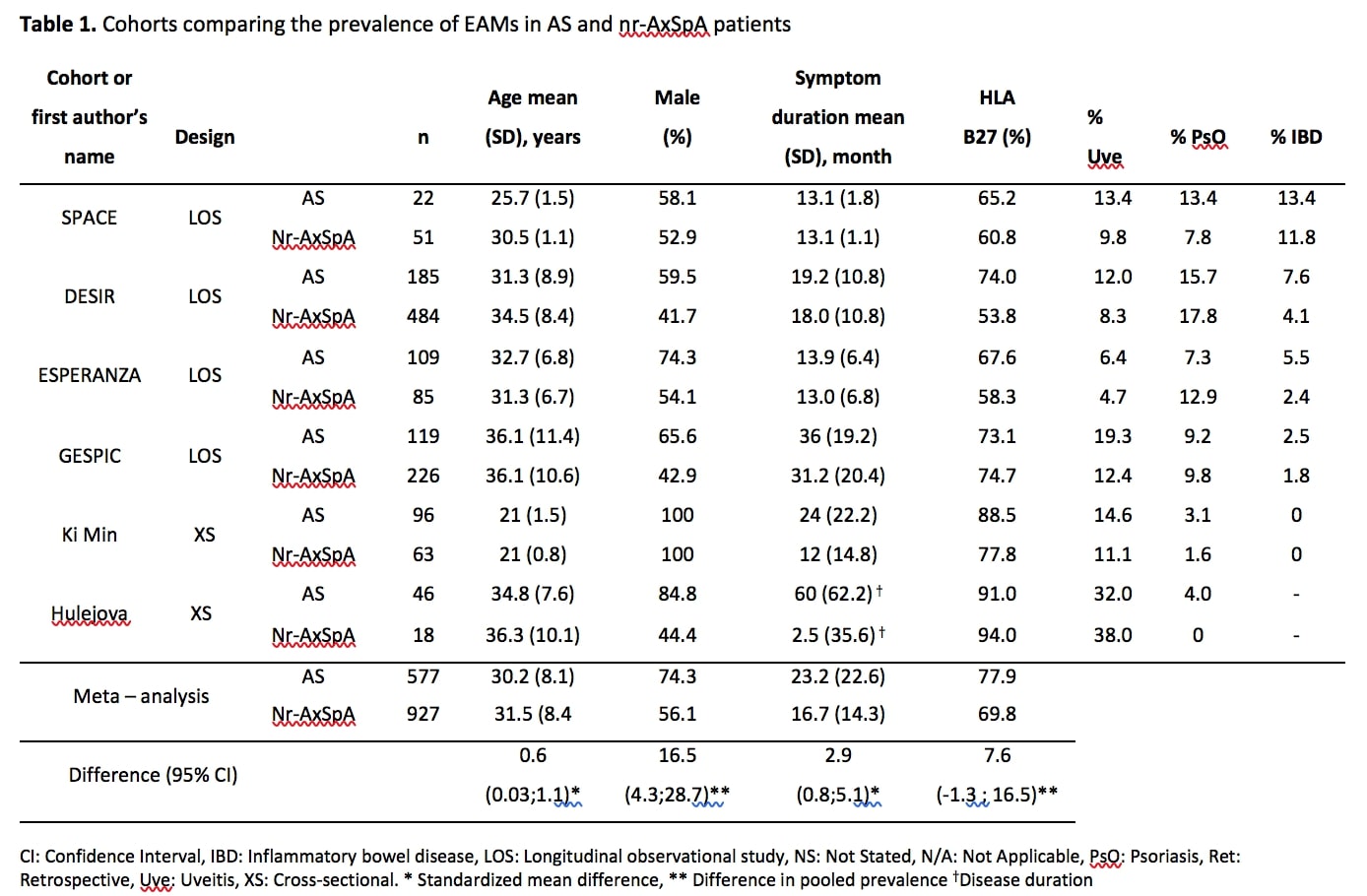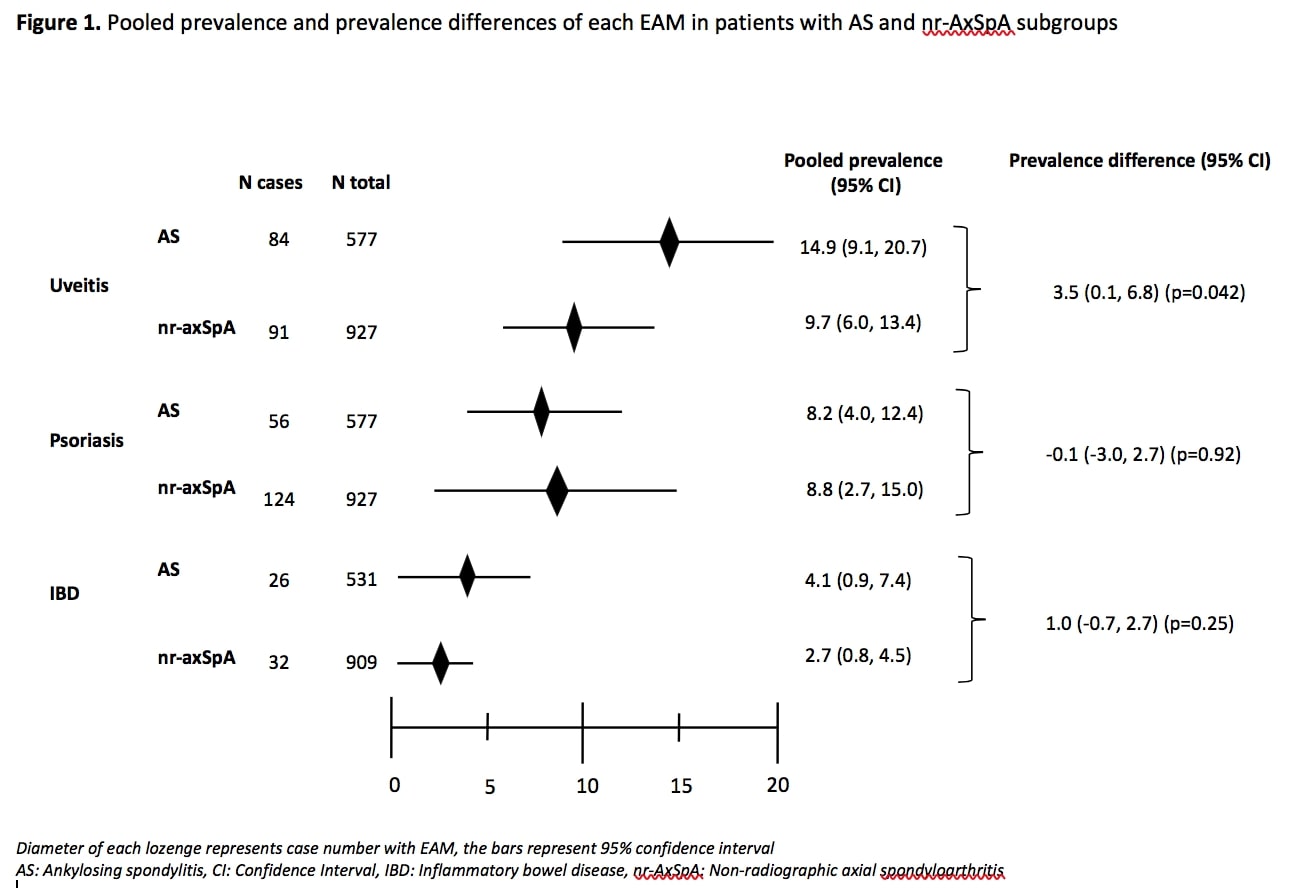Session Information
Date: Sunday, November 8, 2020
Session Type: Poster Session C
Session Time: 9:00AM-11:00AM
Background/Purpose: Uveitis, psoriasis and inflammatory bowel disease (IBD) are Extra-articular manifestations (EAM) of axial spondyloarthritis (axSpA). A recent meta-analysis comparing EAMs in patients with ankylosing spondylitis (AS) and non-radiographic axial spondyloarthritis (nr-axSpA) (mean symptom duration: 1.2 to 17.7 years in AS, 1.0 to 12.1 years in nr-axSpa) reported higher prevalence of uveitis (23.0% vs. 15.9%, AS vs. nr-axSpA), however, similar prevalences of psoriasis (10.2% vs. 10.9%, AS vs. nr-axSpA) and IBD (4.1% vs 6.4%, AS vs. nr-axSpA) in patients with AS compared to nr-axSpA. Nonetheless, data comparing the prevalence of EAMs in early AS and nr-axSpA patients are lacking.
Methods: A systematic literature review was conducted in Pubmed up to 31.12.2019. Keywords referring to EAMs and early axSpA were used, publications reporting prevalence of at least one of the EAMs in patients with early AS and nr-axSpA (mean symptom duration ≤5 years). For longitudinal studies, article with largest participant number from that cohort was included. Case reports and reviews were excluded. Data were collected according to a pre-defined collection form. Prevalences of each EAM in AS and nr-axSpA were assessed by meta-analysis of proportions, using a random-effects model and the DerSimonian & Laird method. The prevalences were compared between the AS and nr-axSpA populations by calculating a pooled risk difference using R based software (Jamovi version 1.2).
Results: Of 667 articles, 6 were analyzed and all were cohort studies (details in Table 1). For uveitis and psoriasis 1504 (577 AS and 927 nr-AxSpA) patients and for IBD 1440 (531 AS and 909 nr-AxSpA) with early SpA were analyzed to compare the prevalence of each EAM in AS and nr-AxSpA patients: weighted mean ages 30.2±8.1 and 31.5±8.4 years (standardized mean difference: 0.6 (0.03, 1.1) years), weighted mean axSpA symptom duration 23.2±22.6 and 16.7±14.3 months (standardized mean difference: 2.9 (0.8, 5.1) months), 74.3% and 56.1% male (pooled risk difference: 16.5% (95% Confidence Interval (CI); 4.3, 28.7)) , 77.9% and 69.8% (pooled risk difference: 7.6% (95% CI; -1.3, 16.5)) carried HLA-B27, for AS and nr-AxSpA, respectively. In pooled analysis uveitis prevalence was 14.9% (95% CI; 9.1, 20.7) in AS and 9.7% (95% CI; 6.0, 13.4) in nr-axSpA, resulting in a difference in pooled prevalence of 3.5% (95% CI; 0.1, 6.8) (p=0.042); psoriasis prevalence was 8.2% (95% CI; 4.0, 12.4) in AS and 8.8% (95% CI; 2.7, 15.0) in nr-axSpA, resulting in a difference in pooled prevalence of -0.1 % (95% CI; -3.0, 2.7) (p=0.92) and IBD prevalence was 4.1 % (95% CI; 0.9, 7.4) in AS and 2.7% (95% CI; 0.8, 4.5) in nr-axSpA, resulting in a difference in pooled prevalence of -0.3 % (95% CI; -0.7, 2.7)(p=0.25) (details in Figure 1).
Conclusion: EAMs are frequent in early axSpA either AS or nr-axSpA. Higher prevalence of uveitis in AS patients compared to nr-axSpA patients may suggest the appearance of new cases over follow-up. Physicians need to screen carefully for EAMs at diagnosis and over follow-up especially for uveitis.
 Table 1. Cohorts comparing the prevalence of EAMs in AS and nr-AxSpA patients
Table 1. Cohorts comparing the prevalence of EAMs in AS and nr-AxSpA patients
 Figure 1. Pooled prevalence and prevalence differences of each EAM in patients with AS and nr-AxSpA
Figure 1. Pooled prevalence and prevalence differences of each EAM in patients with AS and nr-AxSpA
To cite this abstract in AMA style:
Bilgin E, Kalyoncu U, Gossec L. Prevalence of Extra-Articular Manifestations in Early Ankylosing Spondylitis versus Non-Radiographic Axial Spondyloarthritis: A Systematic Literature Review and Meta-Analysis of 1504 Patients [abstract]. Arthritis Rheumatol. 2020; 72 (suppl 10). https://acrabstracts.org/abstract/prevalence-of-extra-articular-manifestations-in-early-ankylosing-spondylitis-versus-non-radiographic-axial-spondyloarthritis-a-systematic-literature-review-and-meta-analysis-of-1504-patients/. Accessed .« Back to ACR Convergence 2020
ACR Meeting Abstracts - https://acrabstracts.org/abstract/prevalence-of-extra-articular-manifestations-in-early-ankylosing-spondylitis-versus-non-radiographic-axial-spondyloarthritis-a-systematic-literature-review-and-meta-analysis-of-1504-patients/
